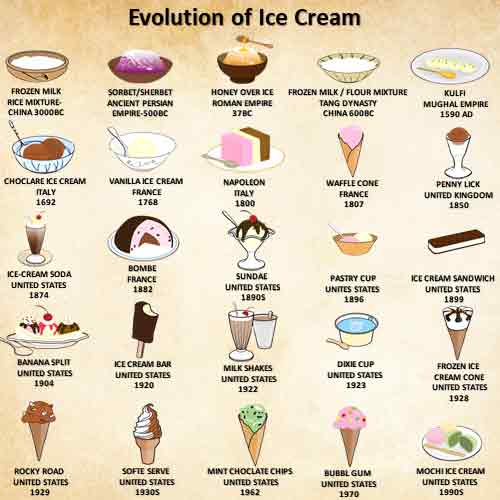Ice cream is the most desirable and delicious mind-refreshing dessert, which is loved by all age groups, especially children. And there are many flavors available, which would make your day just awesome. But do you know, how ice cream was invented? Well, that would be a little confusing. So, we shall be discussing the origins, evolution, and cultural impact of this beloved treat.
Origin of Ice Cream
Before the idea got popped into the mind, who had originated it? You must know its beautiful origin, and it was really a fascinating history of three major continents. During the 4000 BCE period, China accidentally invented ice cream by freezing milk and rice mixtures. Later, it was carried out by the Western world by Italy. And, finally, it was made accessible to the general public by France around 500 BCE.
Around 500 BCE, the Persians were known to serve saffron and fruit-infused snow as a summer dessert to their royal courts. In ancient Rome, Emperor Nero would send his servants to the mountains to collect snow, which was then mixed with honey and fruits to create a refreshing treat. Meanwhile, the ancient Greeks also enjoyed a similar dessert made from snow, honey, and fruit juices.
In the year of Antonio Latini (1642–1692), a Spanish Viceroy in Naples worker had made a recipe for sorbetto (milk-based). And it was the time when it was made “official” ice cream.
Well, there are many theories, but the current flavor of ice cream that we are enjoying today. It is a result of the interesting ancient history of ice cream invention and experiments.
Evolutionary Phases of Ice-Cream
The development of ice cream required several investments, innovations, and fresh ideas from nations all over the world before it was feasible in the present period. In order to grasp how the evolution of ice cream continues from ancient times through the Middle Ages and up to the present. You must first comprehend its historical evo lution. In this section, we’ll talk about all the stages of evolution that have occurred around the globe.
Phase-1(Arabic Ice-Cream)
Booza is a famous traditional Eastern Levant frozen dairy dessert from Arabian-style inventions. It was made with cream, sugar, milk, mastic, and sahlab (orchid flour). Caliphs, the Islamic rulers of Arab Andalusia, used the techniques of ice-cream making by Mount Hermon to cool milk. In the 13th century, Marco Polo returned to Italy from his adventures in the Far East and introduced the idea of frozen sweets. By adding milk, cream, and eggs to the mixture.
Phase-2 (Italian Renaissance Ice-Cream)
Around the year 1500 in Florence at the court of the Medici, his evolution had drastically impacted the ice-cream inventions. During that era, the ice-cream flavors were among the top desserts. In France, Catherine de’ Medici married to King Henry II in the 16th century.
And, she transferred the ice-cream recipe to French chefs. Later, it was becoming so famous in the wedding feast and lavish dinning. In England, King Charles I , it could not be a hidden recipe by the 18th century. And, ice cream recipes publicly appeared in cookbooks, and the highly- demanding dessert categories.
Read More: Ice Cream Machines Demo
Phase-3 (American Ice-Cream)
With the increasing popularity around the globe, Americans also had tasted the ice-cream categories in the 1700s. Additionally, after wards it came under their top-most loved desserts. Notable figures such as George Washington, Thomas Jefferson, and Benjamin Franklin were known to have enjoyed ice cream.
In the 19th century, technological advancements, such as the invention of the hand-cranked ice cream freezer in 1843, made the production of ice cream more efficient. This led to the opening of the first ice cream parlor in the United States in 1851. The introduction of commercial refrigeration in the early 20th century made the production and distribution of ice cream even more widespread, solidifying its place in American culture.
Phase-4 (Modern Era Ice-Cream)
(From1945 until today), the ice-cream invention had already covered the different phases and categories differences in cooking styles, fruits combination, sorbetto etc. Today, ice cream is enjoyed worldwide and has become an integral part of many cultures. Globalization has introduced a plethora of flavors and variations, from Japan’s mochi ice-cream to Italy’s creamy gelato and Turkey’s stretchy dondurma.
Each country has put its unique spin on this classic treat, resulting in a diverse range of flavors and textures to explore. Due to the new techniques overs refrigeration tools and freezing technology with the flavor combination. We have seen many advertising over the bars, cafes, dinning restaurants, TV advertisements, slogans and many more. And, today, people like to enjoy their favorites cuisine with ice-cream combinations.

Historical facts about Ice cream
- Around (16th century): It was the phase of Indian subcontinent famous ice-creams. And, Indian ice-cream lovers mostly recommend Kulfi and milk-based ice-creams (Mughal Empire origin). It was a modified version of Persian ice (Bastani Sonnati).
- Around (17th–18th century): In the era of 1718, England enjoyed the recipe of flavored ice cream.
- (Around the 18th Century): The refrigeration methods were enhanced. So, it was the era when frozen desserts were widely spread.
- Modern Era (21st Century): You can see the differences between fruit-based, honey-based, and different categories of ice cream diversification.
Cultural Impact of Ice-Cream
Our society is increasing its demand and craving for newly invented food items and desserts on a regular basis. So, this had also given a chance to the ice-cream varieties. As, we discussed about the ancient history of ice cream. So, with the passing of BC and hundreds of years. The current flavors that we are enjoying today have filled a gap in tasty, crunchy, and delicious dessert options globally. The inventions were for milk-based sorbetto, chocolate, vanilla, strawberry, butter pecan, etc. It has increased its taste diversification from ancient times to current trends across the globe. Also, many ice-cream making machines also invented so that the ice-cream making styles could be enhanced more.

In addition, ice cream has served as inspiration for a variety of promotional techniques across artistic mediums, including painting and sculpture, TV ads, as well as for several novels and documentaries. Further, it started a significant value system for the children’s enjoyments, stress or heartache relief for youngsters & professionals, and many others. This dessert’s appeal to all people has allowed it to inspire and unite people of all ages and cultural backgrounds.
Ice-Cream Trends in Modern History
In the early 20th century, the ice cream industry saw a reportedly rapid growth in the color, size, textures, and flavor of modern ice creams. So, with the industrialization and production of ice cream, it became the most desirable dessert in modern history. Here, we have accumulated the current plethora of ice cream in modern history.
- Extreme Desserts: Social media has impacted the ice-cream craze, which includes promotion of giant milkshakes, flavored ice cream, and many other ways to share a memorable experience. It includes Black Tap milkshakes in New York City and the massive sundaes (served in waffle bowls with ice cream) at Ghirardelli in San Francisco. So, these cravings for extreme dessert options have drastically increased the potential of ice cream needs and their industrialization.
- Lifestyle and health-conscious ice cream: With the changing of lifestyles, people are becoming more health-conscious. So, the ice-cream evolution has majorly shifted its wings towards health-conscious diets. It includes low-calorie, low-fat, and low-sugar-based desserts and foods. So, here, you can have many benefits over the ice cream varieties. I.e., non-dairy ice cream, fruit-combined ice creams, sundaes, and cones.
- Non-Traditional Forms: Here, the ice-cream shapes were enhanced. It includes ice cream shapes beyond traditional forms like cones and cups. Ice cream sandwiches, popsicles, and even ice cream tacos and many more.
- Snacking on ice-creams: A snacking revolution in ice cream has totally changed the ice cream industry. And new innovations and ideas over the shape, size, portability, and cookie dough chunks have emerged in current trends.
Reasons for Ice-Cream Love
Ice cream’s invention had mainly impacted cultural values and the craze for it in society. Here are the main reasons why it got so much love among all age groups:
- Energy and Immunity Booster: Ice cream boosts your energy levels right away and has several positive health effects. Vitamins A, D, selenium, and zinc are abundant in ice cream ingredients. Furthermore, it has significantly fueled the ice cream craze among young people, who regularly consume its various flavors to boost their immune systems.
- Mood-Refreshers: Ice cream has some mental benefits, as whenever you eat its different flavors, it makes your mood swing off. And you will be energized and happier all day.
- Nutritious Values and Added Food: Once you finish up your meals, you can have ice cream to add a spark and nutritious add-ons to your food. So, it really increases the nutrition level of your food.
- Satisfy your children’s desires: Children will love and enjoy their meals once they see the added flavor of ice cream.
Conclusion
The history of ice cream is a testament to humanity’s love for indulgence and innovation. Ice cream has evolved from its ancient roots to the limitless variety of flavors and forms we enjoy today, becoming a crucial component of our world’s cuisine. Additionally, the food and hospitality industries benefited greatly from flavor-related innovations and inventions. Ice cream continues to be a popular dessert that brings people together and provides a little sweetness to our lives even as we experiment with new flavors and cooking methods.



